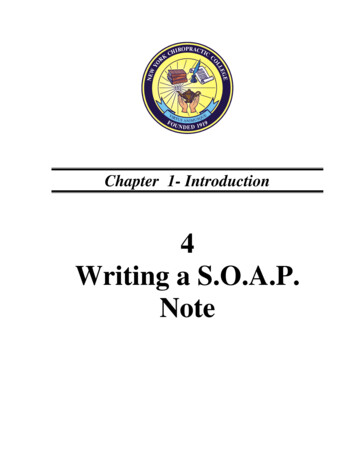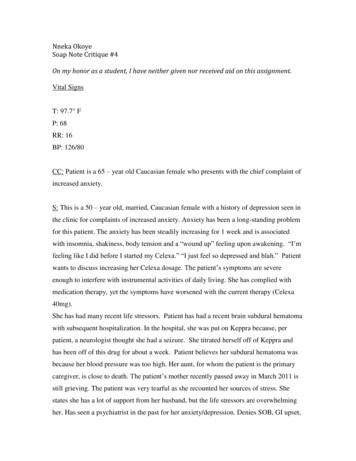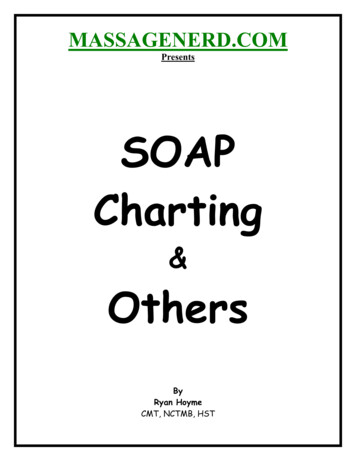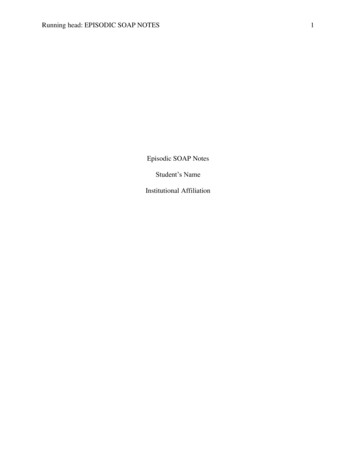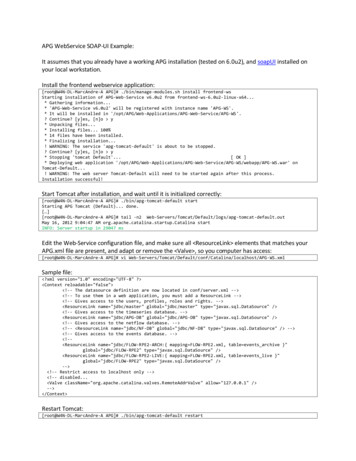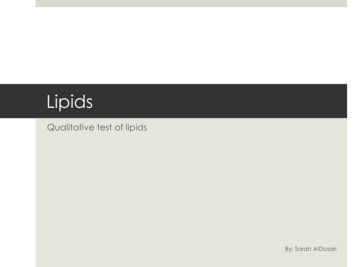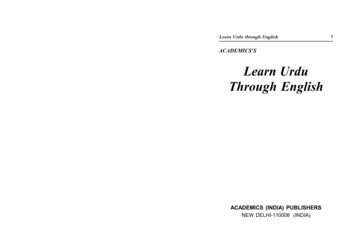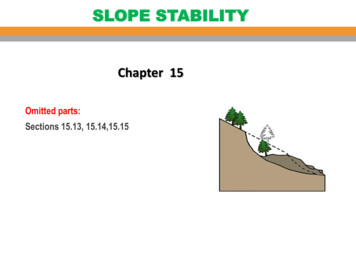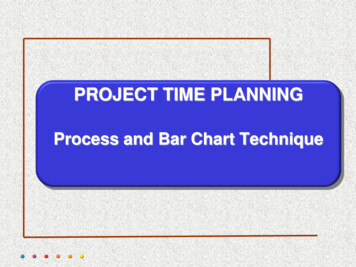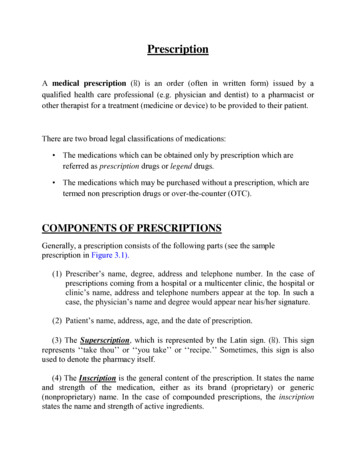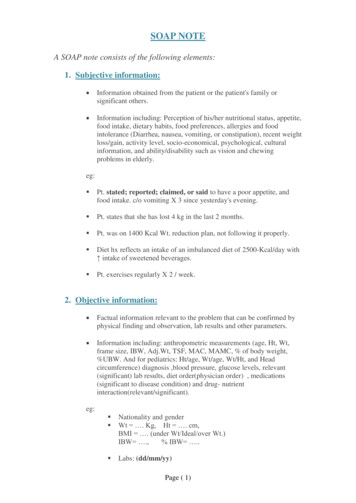
Transcription
SOAP NOTEA SOAP note consists of the following elements:1. Subjective information: Information obtained from the patient or the patient's family orsignificant others. Information including: Perception of his/her nutritional status, appetite,food intake, dietary habits, food preferences, allergies and foodintolerance (Diarrhea, nausea, vomiting, or constipation), recent weightloss/gain, activity level, socio-economical, psychological, culturalinformation, and ability/disability such as vision and chewingproblems in elderly.eg: Pt. stated; reported; claimed, or said to have a poor appetite, andfood intake. c/o vomiting X 3 since yesterday's evening. Pt. states that she has lost 4 kg in the last 2 months. Pt. was on 1400 Kcal Wt. reduction plan, not following it properly. Diet hx reflects an intake of an imbalanced diet of 2500-Kcal/day with intake of sweetened beverages. Pt. exercises regularly X 2 / week.2. Objective information: Factual information relevant to the problem that can be confirmed byphysical finding and observation, lab results and other parameters. Information including: anthropometric measurements (age, Ht, Wt,frame size, IBW, Adj.Wt, TSF, MAC, MAMC, % of body weight,%UBW. And for pediatrics: Ht/age, Wt/age, Wt/Ht, and Headcircumference) diagnosis ,blood pressure, glucose levels, relevant(significant) lab results, diet order(physician order) , medications(significant to disease condition) and drug- nutrientinteraction(relevant/significant).eg: Nationality and genderWt . Kg, Ht . cm,BMI . (under Wt/Ideal/over Wt.)IBW .,% IBW . Labs: (dd/mm/yy)Page ( 1)
Alb . ( / ),Cholesterol . ( / ).TG . ( / ), HTN, IDDM,CHD . etc Medications:List all significant, drug-nutrient interaction(relevant only). Diet Rx: 1500 Kcal IDDM , salt diet.3. Assessment: Interpretation of the patient status based on subjective and objective data. Evaluation of nutritional history as it is related to medical condition. Estimation of nutritional requirements and evaluation of the given diet order. Assessment of lab results as they apply to nutritional status. Assessment of DNI as they apply to nutritional status. Assessment of comprehension / motivation and anticipated problems affectingpatient's compliance. Put in consideration the patients weight status, physical activity , and patientsunderstanding of the diet Instructions regarding his/her disease condition (ex.DM on OHA or Insulin)eg: A 46 Y/O Saudi , known case of/newly diagnosed with .admittedfor ., grade II Obese. major food preferences. Motivated to loseWt. but needs education regarding Wt. reduction plan. Prolonged use of Lasix may correlates to the poor electrolyte balance. Nutritional assessment:Kcal/day . (Specify equation)CHO gm/kg (gm/day) %CHON . gm/kg (gm/day) .%Fat . gm/kg (gm/day) .%Cover the following when needed according to disease condition :Na . gm/dayK . gm/dayFluids .mls/day Diet Recommendation: .Page ( 2)
4. Plan: Action to be taken Recommendation for nutritional care, or any modification in previous plans(ex. Changes in diet to a regular or tube feeding .est). Further investigation/ work up , and monitor labs. Any referral suggested for dietitian clinic/social worker. Any suggested supplements for prescription. Counseling and education on diet. For patients on tube feeding (interal Feeding):1-Spesify Type of Formula2- Total Goal (Rate goal)3- Initial Rate4- Specify significant nutrients (ex. Kcal and CHON) Follow up plan.eg: start pt. on 1200 kcal, salt, fat diet. Monitor glucose level, Albumin, electrolytes. Check on food intake and appetite, update food preferences, andmodify diet as needed. pt. was instructed on 1200 Kcal, salt, low fat diet, diet sheet andwritten materials were provided, check on compliance. F/U in 3/7, RTC in 4/52.Some Guidelines for documentation: Use black/blue pen. No soft, multicolored pens or pencils.Documentation should be complete, clear, legible ,complete , andaccurate .Address service, date, and time. make sure that each page of themedical record has the patient's stamp or written name and hospitalnumber.Page ( 3)
Start right after the last note in the chart . or start in a new page andstrike out any space behind. Make sure all entries should be in achronological order.keep writing in consecutive lines. No blank lines between texts.if you make a mistake, cross it out with a single line , write error, andinitial it. Don't white-out or use adhesive labels.watch out for grammatical and error mistakes.personal positions, comments criticizing others should be avoided.at the end of your note, type your name , and sign it. Write yourprofessional title or credentials.Example:OBESITYMohammad, 39 years old man heavy smoker, weighed 120 kg ,height 171cm withhistory of obesity , bipolar disorder, hypothyroidism and mild depression, Married ,abusiness man doesn’t have time to do physical activity .He states that he had regainedan enormous weight since diagnosed hypothyroidism , since then ,he experienceddifficulties in losing weight and thus disappointed with no motivation.On physical examination : TSH 11 unit/ml, FT3 150ng/dl, FT4 150ng/dl , Lithium .8 ,HDL 35mg/dl, LDL 270mg/dl ,Cholesterol 390mg/dl, TG 410mg/dlHis medications are: lithium carbonate 1200mg/day, lamictal 200mg/day, thyroxine100mcg/day, Zoloft (lustral) 200 mg/day .His Health care practitioners have repeatedly advised weight loss , exercise and tostop smoking to improve his health status. He tried several dietary regimens providedfrom different diet centers, as he mentioned "I have tried everything, but I couldn’tmaintain what I lose in the beginning of the diet, where at this point, I feeldisappointed and starts to overeat and regain what I had lost, there must be somethingwrong ".He started (on his own) taking Orlistat 120mg 3 times daily, then shifted tosibutramine 15mg/day for 2months until he experienced palpitation and dryness of themouth with immediate weight loss at the expense of feeling anxious. Weight alwaysreturned faster than it came off. At that point, He seeked a medical advice andunderwent a gastric banding surgery in august 2008. After 9 months he had lost over15 kg when he started to feel better and delighted, However weight loss rate declinedand even regain some of the weight lost, he was eating anything he wants with noPage ( 4)
restrictions as he states " I felt the the band is not working anymore " he consulted hisgastric surgeon who took an appointment with for further tightening of the band .Hewas interviewed by his dietitian, where instructed regarding his dietary regimen .Questions ;How can you do a comprehensive nutritional assessment in case of Mohammad?Based on your assessment, apply effective nutritional intervention & plan to helpmohamad to overcome the difficulties he is facing regarding her weight management?Do you think that mohammad is a good candidate for such bariatric surgery? Andwhy?Describe the mechanism of action & side effects of the medications taken bymohammad?,do you think that appetite suppressing drugs is a good choice formohammad?and why ?(AT CLASS; PREDICT WHAT ARE THE CONTENTS OF THEINTERVIEW BETWEEN MOHAMMAD AND HIS DIETITIAN WAS?)MODEL ANSWEROBESITYPreliminary Information SheetAge 39yrs ,Sex male ,Wt. 105kg , Ht. 171cm, BMI wt/ ht2 105/(1.71)2 35.9kg/m2 " obese class2", IBW 24 x (1.71)2 70.2kg , % IBW 105/ 70.2 x 100 149.6% " obese", adj wt. 105-70.2x 0.25 70.2 78.9 kg.Diagnosis:Bipolar disorder, hypothyroidism, obesity.Medical hx:Mild depression, heavy smoker.Labs:TSH 11 unit/ml ( H), FT3 150 mg/dl (N) , FT4 150 mg/dl, lithium 0.8 (L),LDL 270 mg/dl " high" , total chole. 390 mg/dl " high" , HDL 35 mg/dl(L), TG 410 mg/dl (L)Medication: Lithium carbonate, lamictal, thyroxin, Zoloft.Nutrient – drug interaction: øPage ( 5)
CalculationREE 66.47 13.75(78.9) 5(171) - 6.76(39) 1742.7 kcal/ dayTEE 1742.7 x 1.3 2265.5 Kcal/ dayPro. 20% 113 g/ dayFat 30% 75.5 g/dayCHO 50% 283 g/dayMedication:MedicationIndicationLithium carbonate Used to treat depression inbipolar disorderlamictalThyroxinAnticonvulsant, may beused to delay theoccurrence of moodproblems in bipolardisorder.hypothyroidismzoloftTo treat depression.Side effectFrequent urination, mildthirst, nausea, diarrhea,vomiting.Constipation, diarrhea,vomiting, nausea, stomachupset or pain, headache.Allergic reaction, appetitechange.Constipation, diarrhea, drymouth, stomach upset,nausea, vomiting, loss ofappetite.Clinical notes (SOAP):Date24/2/0911:00 amS:Pt. has regained wt. since diagnosed with hypothyroidism, he tried several dietaryregimens but failed, he started taking orlistat then shifted to sibutramine & losingwt. , but he regained, he did gastric banding & lost 15 kg in 9 mo., but the wt lossdecline & gain some wt., he is disappointed & eating anything with norestrictions, no PA.O:Age 39yrs ,Sex male ,Wt. 105kg , Ht. 171cm, BMI wt/ ht2 105/(1.71)2 35.9kg/m2 " obese class2", IBW 24 x (1.71)2 70.2kg , % IBW 105/ 70.2 x 100 149.6% " obese", adj wt. 105-70.2x 0.25 70.2 78.9 kg.Page ( 6)
Pt. has Bipolar disorder, hypothyroidism, obesity.Labs:TSH 11 unit/ml ( H), FT3 150 mg/dl (N) , FT4 150 mg/dl, lithium 0.8 (L),LDL 270 mg/dl " high" , total chole. 390 mg/dl " high" , HDL 35 mg/dl(L), TG 410 mg/dl (L)Diet Rx: øMedication: Lithium carbonate, lamictal, thyroxin, Zoloft.Nutrient – drug interaction: øA: 39 yrs old, Saudi male, obese grade 2 ( BMI 35.9 kg/m2), has bipolardisorder, mild depression, he experienced difficulties in losing wt., he trieddietary regimens, drugs, gastric banding, he is eating everything & no PA, he is atrisk to CVD ( LDL, Chole, TG, HDL, heavy smoker)Nutritional assessment:TEE 2265.5 kcal, pro. 113g, fat 75.5g, CHO 283g.P: Provide 2265 kcal in regular diet, sex small frequent mealsProvide pro. 113g, fat 75.5g, CHO 283g, chole 300 mg, fiber 2535g, fluid 2-2.5 L.Encourage pt. to follow the diet & increase PA.Advice pt to stop smoking.f/u in 1/7This SOAP NOTE GUIDELINES where prepared and reviewed by: Ghalia Abdeen(Coordinator), Madawi Al-Dwhayan (Ass. Coordinator), Dara Al-Dissi, Jazi Bin Zaraa,Ghadeer Al-Juraiban , and Muneerah Al-Muhanna .Final Review by Dr.Saada Al-OrfApproved by The CHS Chairman Deputy; Dr. May Al-MuammarCollege of Applied Medical Sciences; KSUPage ( 7)
SOAP NOTE A SOAP note consists of the following elements: 1. Subjective information: Information obtained from the patient or the patient's family or significant others. Information including: Perception of his/her nutritional status, appetite, food intake, dietary habits, food preferences, allergies and food
